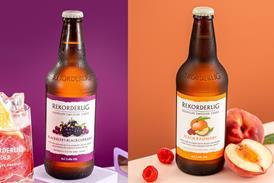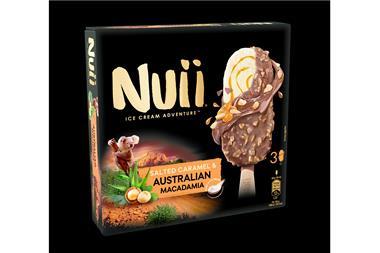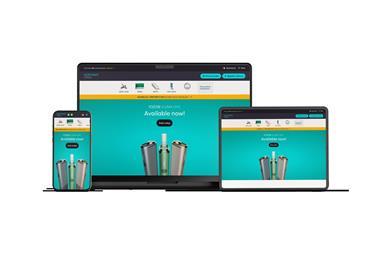Ready meals, ice cream and meal deals are helping to keep retailers out of the cold when it comes to success in the frozen food category
There was a time, not too long ago, when frozen foods were seen as fresh food’s poor relation. How times have changed. Today, ready meals and family-friendly lines are encouraging shoppers and convenience retailers to pay much more attention to frozen.
The retail frozen food sector exceeded £6bn in the second half of 2017, while the value of frozen food sales increased by 6.1% in the year to 3 December 2017.
The appeal isn’t surprising given few product categories can offer the kind of convenience and variety that can be found in the frozen aisle. And at John Mitchell’s Spar store in Ceres, Fife, it’s multipacks that are pulling value-conscious shoppers in.
“I think frozen is going the way of chocolates and sweets,” he says. “People are looking to buy the multipacks and large bags because they know they are better value. Those kinds of products have become much more prevalent and captured the family market.”
To capitalise on this trend, John has added a new freezer to his store which has increased frozen capacity by 25%. This means he can offer an increased number of lines for the summer and ensure he’s offering a good balance of products. He finds that Bird’s Eye frozen vegetables and kid’s ice lollies are among the most popular lines.
He’s on the right lines according to latest statistics. Frozen vegetables were up 7.2% in value in the year to 3 December 2017, with ice cream up 8.5% in value.
John adds: “We know, from speaking to people in the industry, that frozen is something that we need to make more of and it’s an area we are looking to keep on improving.”
Frozen food is a category that Samantha Coldbeck, owner of Premier Wharfedale in Hull, is also focusing on. While her 1,600sq ft store can’t offer the breadth of range found in the freezers of the multiples, her focus on value is really paying off.
“I think it’s crucial for c-stores to have a strong frozen foods offer,” she says. “It went out of fashion for a while, but now people are so busy that they have come back to the freezers because they want quick meal options.
“Premier has started doing frozen meal deals where customers buy three or four products to make a meal and save about £6, so they are really competitively priced.”
The price point is hitting the mark for Sam and her customers. “At the moment, we have two different promotions running,” she explains. “One is for fish fingers or battered cod, Birds Eye garden peas and chips. The other one is for two pizzas, chips and a frozen chocolate cake. Most deals cost between £4 and £6.”
Frozen meal deals are a new foray for John. “We always did deals on chips and pizza separately,” he says, “but we never did any cross-category promotions in the freezer until now. We want to see how customers will react and whether we will see an increase in sales.”
Jo Devenish, co-founder of premium frozen ready meals supplier Gourmade, believes that along with appealing to those on a budget, frozen meals are great for those consumers who don’t have time to cook from scratch.
She says: “The UK is a busy nation – couple that with the rise in single-person households and longer working hours and convenience is essential. Frozen ready meals can provide consumers with something quick and easy to cook that taste great, too.
“Stocking premium frozen brands that offer a point of difference and great taste will attract discerning shoppers who are looking for an alternative to cooking from scratch at home.
She also believes that shoppers’ concern over food waste could also drive sales in the frozen foods category, as consumers worry about wasting money and its effect on the environment.
“Consumers are becoming increasingly aware of the effect we are having on our planet,” she points out.
“Cooking from scratch and the short shelf-life of fresh products produces more waste than people realise – for both retailers and consumers. Frozen meals’ portion control is a great way to help reduce unnecessary waste.”
John has been pushing his frozen ready meals range, but he is concerned that success in the freezer could impact on sales in the chiller.
“The popularity of frozen is growing,” he says, “but we don’t want frozen ready meals eating into the success of chilled. That’s why we tend to stick to the more traditional lines such as chips, pizza and ice cream.”
Samantha is also taking a cautious approach, trying to keep the balance between chilled and frozen ready meals.
“We try to offer them both,” she says, “but we are lucky that we have enough freezer space. I would say we have about six metres, which is generous for a store of our size.”
Frozen staples
McCain marketing director Mark Hodge believes offering a quality frozen range involves offering restaurant-inspired products.
He says: “Consumer insight tells us that one- and two-person households take inspiration from out-of-home dining when cooking at home. We wanted to replicate that experience in the home, ensuring our consumers have a broad range of high quality, great tasting products to choose from.”
In line with these findings, Samantha has expanded her range of frozen chips massively in recent years as she has noticed customers looking for more trendy frozen products.
“McCain sweet potato chips and spicy wedges are really on-trend at the moment,” she says. “About five years ago we were just doing regular, good quality chips, but now I would say we have about eight different varieties.”
She adds: “There are also different ways of cooking them – whether in the microwave or the oven – which is key for convenience because it gives customers more choice.”
Mo Razzaq, owner of Family Shopper Blantyre, in Glasgow, gives customers options by offering a mix of branded lines and own-label products. “As a result, our frozen food sales are very healthy,” he says.
“Our bags of frozen broccoli, carrots and peas have been really popular. Because they come in large formats and are own label Family Shopper, the pricing is very good for our customers.”
Samantha has also been taking advantage of the growing popularity of own-label products, but points out that people’s price-consciousness varies greatly throughout the month. and so brands have a big part to play.
“We try to stock a mix of own-label and branded products,” she asserts, “and we tend to go for the ‘good, better, best’ merchandising strategy for frozen foods. Our store in Hull is in quite a deprived area so we need to have the value products in stock during the week.
“However, I’ve noticed that customers are more willing to trade up on the weekend, or if it’s pay day. The rest of the time people look for the cheaper option, but when it’s pay day people have so much money they don’t know what to do with it.”
Despite intense competition from own-label products and the discounters, McCain category controller Naomi Tinkler believes it is important for c-store retailers to push branded products to help drive growth in the frozen category.
“The value increase in frozen potato has, in part, been driven by delivering solutions that add value to shoppers’ lives,” she says. “As a brand, we know that our products need to deliver on quality and taste and that’s why we want to be able to offer a range of potato products that can be included in various meal occasions.
“Tapping into new consumer groups with innovative NPD is key to brand and category growth, and a key focus for us is keeping our ranges relevant to today’s shoppers by offering a variety of products that offer interesting flavours, seasonings and cut types.”
Quorn beefs up meat-free range
Quorn has created a core frozen foods range for the convenience channel, in order to take advantage of the family meal occasion.
The five-strong pricemarked line-up comprises meat-free crispy nuggets, burgers and sausages (rrp £2.29), as well as meat-free cottage pie and lasagne ready meals (rrp £1.79).
Gary Routledge, national account manager at Quorn Foods, says: “Meat-free is one of the fastest-growing categories in frozen, and with Quorn accounting for more than 49% of all frozen meat-free sales, retailers can use Quorn as a beacon brand as part of their ‘meal for tonight’ offering.
“Frozen meat-free products are also attracting new consumers into the frozen category, so it’s important that retailers stock products such as nuggets, burgers and sausages as these make the introduction to meat-free really simple.”
Meat free
With year-on-year sales growth of 15% in the UK alone (IRI & Kantar Worldpanel 52 w/e 31 March 2018) the frozen meat-free category is another area of opportunity for retailers.
Mo is trying to capitalise on the meat-free trend in his store. “We’ve tried to focus more on our vegetarian range with frozen ready meals from Quorn and Linda McCartney,” he says. “We’ve definitely noticed that a higher proportion of people are now following a vegetarian and vegan diet.”
Gary Routledge, national account manager at Quorn Foods, points out that c-store shoppers are increasingly looking for healthier frozen products to create easy-to-prepare family dinners.
He says: “Meat-free is becoming more relevant to UK consumers with 47% of shoppers reducing their meat consumption (YouGov, 2017). Health is a major driver of that, but so too is sustainability as consumers start to recognise the impact of intensive meat production on the planet.”
John recognises that more consumers are being led by health trends, which is why he has started selling a selection of gluten-free frozen products. However, his shoppers aren’t quite ready to go meat-free just yet.
He says: “The meat-free market is a little niche for us. We do keep Quorn and Linda McCartney products in the freezer, but I can’t say I’ve noticed a huge increase in demand for those in my store.”
Samantha is also finding it a challenge to persuade customers to buy into the meat-free category. “Meat-free frozen meals are something we stock, but they’re not a massive area for us,” she admits. “People like their meat in Hull.”
However, Samantha still offers a good range in order to appeal to different types of shoppers. “Giving customers a meat-free option is a good thing,” she says, “which is why we keep a lot of the Quorn and Linda McCartney range in the freezer. It’s better than putting it in the chiller, because they have better dates and last a lot longer.”
Musclefood muscles in on diet market
Online health retailer Musclefood.com has expanded its frozen 10-inch diet pizza range.
The range is designed to appeal to consumers looking for healthy alternatives to some of the UK’s favourite foods and is available to convenience retailers and the wholesale trade.
Flavours now include chicken tikka, margherita, goat’s cheese and caramelised onion & mushroom (rrp £3.50). With fewer than 500 calories per pizza, Musclefood’s diet range is less calorific than frozen alternatives and takeaways.
Each of the diet pizzas also takes just 12 minutes to cook in the oven.
Musclefood.com founder and director Darren Beale says: “Our pizzas were developed especially for dieters looking to keep to their healthy-eating plans, but who also want to eat something that looks and tastes as good as a takeaway treat. The calorie count of takeaway pizza is well into the thousands, so it’s great that we are able to offer an alternative that means people can keep in shape without giving up the food they love.”
He adds: “With each pizza containing less than 500 calories, we believe that this is quite possibly the lowest-calorie pizza available in the UK.”
The frozen Musclefood range includes prepared fish fillets such as salmon and tilapia as well as frozen steak burgers, meatballs and sausages.
The brand also sells a range of prepared frozen meals such as spaghetti ragu bolognese, red thai fish curry and beef lasagne.
Ice cream
Ice cream is traditionally a strong category for convenience stores, but that doesn’t mean there isn’t more opportunity to add value to the category with fresh ideas.
Mo opened his new 1960s-themed in-store dessert bar in May, offering customers a range of ice creams and ice lollies along with speciality cakes, freshly-baked waffles, pancakes and crêpes.
“It’s been a long time coming,” he says. “Some of our shoppers have moved to buying their ice lollies and impulse ice creams from the bar rather than the main freezer.
“That said, the sales haven’t taken anything away from the take-home market as the dessert bar is much more premium. If people want an ice lolly it’s 70p, and if they want a cone it’s £1.50, which means they cost more than those in the frozen aisle.”
Mo says his dessert bar has had a positive effect on his whole frozen range, as customers pick up other frozen products while they are in the store.
The ice cream category has also boosted sales in Samantha’s store, especially now that summer is in full swing.
She says: “We have one freezer that sits next to the beers and wines which holds just ice cream. We do that to try to take advantage of the Big Night In occasion and create linked purchases.
“They sell well all year round, but we are starting to stock more of the big sharing tubs as we get more into the summer.”
Tips to make frozen work for you
Shah Khan, marketing manager for Aviko UK & Ireland, believes convenience stores have a real opportunity to inspire their shoppers with meal solutions from the freezer.
“Giving shoppers a great in-store experience and offering them inspiration for their meal for tonight will not only drive higher value basket spend, it will also drive customer loyalty long-term,” he says.
Aviko’s six steps to meal occasions success:
1. Offer a core range of meal component products: Fresh; ambient; and frozen
2. Stock frozen potato products such as Aviko’s range of fries, diced potatoes, hash browns and gratin, which are essential meal accompaniments. They have wide appeal, sell fast and because they are frozen have a long shelf life
3. Group your meal solutions together to create a focus
4. Communicate the meal-for-tonight offer with posters, displays and banners
5. Offer minimal-preparation recipe cards
6. Introduce some theatre to make the shopping experience really enjoyable.
On a sunny day ice cream sales can jump by 400%, according to Unilever’s Partners for Growth, while simply letting shoppers know that you sell ice cream can increase sales by up to 15%, making POS material outside the store particularly important.
Michelle Frost, general manager at Mars Chocolate Drinks and Treats, believes tubs and share-at-home products also benefit from clear signage. “With eye-catching packaging and familiar brand appeal, we are sure that tubs will bring consumers to the frozen aisle and will soon become a favourite of consumers and retailers alike – emulating the success of our bars,” she says.
Frost advises retailers to watch out for the potential ‘freezer cloggers’ that take up space without generating big sales. She explains: “With so many limited-edition variants flashed in and out of the freezer, it’s important for retailers to understand the potential impact of ‘freezer cloggers’ on long-term sales.
“Selling a small range and focusing on the best-selling brands within each major category segment will help retailers to keep freezers looking clean and tidy. It’s also important to ensure that customers know that you stock their favourite ice creams – and to position the freezer cabinet near the front of the store so these are not overlooked.”
Duncan Hill, managing director of HL Display, believes merchandising that boosts product presentation can help drive sales in the freezer. He says: “With changing consumer perceptions of frozen food has come a renewed focus on innovation and product presentation within the category. Many retailers have moved away from chest freezers to upright freezers with glass doors that keep the cold in. This has encouraged shoppers to browse more in the frozen aisle, and consequently brands have reinvigorated their packaging to make their products stand out.”
Hill points out that the frozen category can be difficult to display, thanks to the variation in shape, size and type of products available, but the rewards for getting the display right can be big.
He adds: “Consumers continue to be cost conscious and they want to reduce wastage and have greater control over portion size. They are therefore keen to explore what the frozen food category has to offer and, with this focus on frozen, independent retailers need to make sure that the presentation of products in their freezer cabinets is excellent to maximise sales opportunities.”
Froneri adds to Rowntree’s lollies line-up
Froneri has introduced three new lollies to its Nestle Rowntree’s range.
The new products – Watermelon, Fruit Pastille Push Up and Fruit Blaster – are designed to appeal to all ages.
Rowntree’s Watermelon (rrp £1 for single, £2.20 for four- pack) is shaped like a watermelon slice, has a high juice content and is designed to be refreshing.
The Fruit Pastille Push Up (rrp £1 for single, rrp £2.20 for six-pack) is a new format for Rowntree’s lollies and capitalises on the popularity of flavours within the brand’s confectionery range. The Push Up range is available in three variants – strawberry, tropical and blackcurrant.
Rowntree’s Fruit Blaster (rrp £1.20 for single, rrp £2.20 for four-pack) combines the popularity of a fruity ice lolly with a toy as the lolly stick can be used as a water pistol. The blaster lolly is flavoured with mango, peach, pineapple and tropical fruit.
Froneri head of UK marketing Charlotte Hambling says: “Our lollies have enjoyed enormous success, but we’re continually looking for new ways to create excitement in the frozen aisle and attract even more shoppers.
“The market for lollies has changed over the past few years. We’ve seen that they’re experiencing organic growth in both summer and winter. We’ve done a lot of work to examine when and why people are eating ice lollies and have seen that consumers are choosing ice lollies because they’re seen as more of a permissible treat for younger members of the family. They also work well at home for families because they’re convenient and easy to share out. Lollies have been a great success story for us and can be for retailers who need to ensure they’re stocking them throughout the year.”
Froneri is investing £400,000 in driving awareness of the new additions. Marketing activity will include in-store activity and POS material.





![PLAUK0125 Jacobs The Trussell Trust Portrait[53]](https://d2dyh47stel7w4.cloudfront.net/Pictures/274x183/6/4/1/322641_plauk0125jacobsthetrusselltrustportrait53_125111_crop.jpg)












![PLAUK0125 Jacobs The Trussell Trust Portrait[53]](https://d2dyh47stel7w4.cloudfront.net/Pictures/380x253/6/4/1/322641_plauk0125jacobsthetrusselltrustportrait53_125111_crop.jpg)








No comments yet